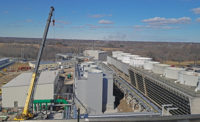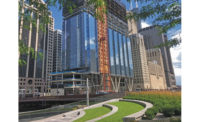Midwest specialty contractors are cautiously optimistic about the current state of the industry months into the COVID-19 pandemic, which has affected nearly every industry worldwide.
In the last full year before the pandemic’s impact, a total of 48 firms responded to ENR Midwest’s annual Top Specialty Contractors survey and reported total regional revenue of $7.29 billion. Last year, 68 firms responded to the survey and reported revenue of $8.84 billion. Respondents covered the 11-state area of Illinois, Iowa, Indiana, Kansas, Kentucky, Michigan, Minnesota, Missouri, Nebraska, Ohio and Wisconsin.
The work these firms performed in 2019 ranged from infrastructure, middle schools, big city airports, correctional facilities, food processing facilities, distilleries and even end zones in Big Ten college football stadiums. The health care sector once again comprised a large chunk of projects across the Midwest, from hospitals in Columbus, Ohio, and Kansas City, Kan., to health care centers in Rockford, Ill., and Cincinnati.
The world has changed since then, and the specialty contracting industry has had to adjust. For some, decisions made in 2019 have helped them navigate the current waters.
“Last year we rewrote our business plan,” says Chuck Goodrich, president of Noblesville, Ind.-based Gaylor Electric Inc. “And thank God we did, because it’s guided us through this.”
|
Related Link |
Goodrich says alternative energy, especially solar, has been a strong point for Gaylor over the last six months. He says it has had an especially big impact on the company in Indiana, Ohio and Illinois. Almost as important for the company has been work on data centers across the Midwest. “That’s been a deal for us,” he says.
Gaylor completed $3.46 million of electrical work on the FedEx International Hub in Indianapolis. Contracted with Shiel Sexton, Gaylor handled all conduits, cabling and distribution including a generator room containing six large generators, all lighting throughout the building and the control panel wiring.
“We put our focus first on people, then reliable resources, insights and outcomes,” says Goodrich. “Overall, it looks like we still may grow in 2020. It feels like things are slowing down a bit, but that’s because electrical contracting can be a year behind. Still, it looks like we’ll see growth—maybe not a lot, like around 5%, but that has to do with all our locations, including in the Midwest.”
“It’s a more challenging market, no doubt,” agrees Tim Moormeier, president of Kansas City, Mo.-based U.S. Engineering. “Our annual revenue has dropped 20% across all companies combined, and probably two-thirds of that is due to COVID.”
U.S. Engineering’s top projects of the year included the University of Kansas Hospital Air Handling Unit Replacement and work on the $1.9-billion new terminal project at the Kansas City International Airport. The airport terminal is the largest single infrastructure project in Kansas City’s history, featuring space for 39 gates. The work also includes a seven-story parking facility with 6,500 parking spaces. In this evolving pandemic environment, U.S. Engineering’s work on data centers, hospitals and schools has kept the company particularly busy over the last months, says Moormeier.
“We rented hotels near hospitals so workers could shower in between jobs, stay with their families and feel safe. I’d suspect from the data we’re about 10% less efficient because of social distancing, but on the other hand we’ve had the lowest incident rate in the last six months at zero incidents.”
– Tim Moormeier, President, U.S. Engineering
“Data centers have kept us very busy,” he says. “And the bigger hospitals have kept us very, very busy. We got involved with the Army Corps of Engineers on the Denver Convention Center for hospital beds. We’ve also seen a big influx in the public school system and how to open them effectively.”
Moormeier also stressed what many company leaders have emphasized: The pandemic has only bolstered company resolve to focus on the safety of workers.
“Mike Zykan, who leads our safety council, has the most stressful job in the company,” says Moormeier. “We are taking contract tracing seriously. We rented hotels near hospitals so workers could shower in between jobs, stay with their families and feel safe. I’d suspect from the data we’re about 10% less efficient because of social distancing, but on the other hand we’ve had the lowest incident rate in the last six months at zero incidents.”
“2020 was and still is a decent year,” says Jesse Roush, vice president of operations for Veit & Co. “Most of our work was in the pipeline in March, and in this region [Minnesota and Milwaukee] COVID hasn’t slowed it down. We were able to quickly adapt to all-digital site management. That turned out to be a good investment for us in 2019.”
Veit, based in Rogers, Minn., maintains a project workload that is 50/50 public/private, according to Roush. He pointed to the company’s work in infrastructure, highways, trails and school buildings. One of Veit’s largest projects is a dredging job at Kingsbury Bay and Grassy Point at the St. Louis River in Duluth, Minn. Veit built barge spreads measuring 40 ft by 60 ft with 2.5-ft to 3-ft draft in order to dredge a total of 350,000 cu yd of sediment and wood waste from the river.
Moormeier, Goodrich and Roush all agree that the pandemic has changed the specialty contracting industry. All three say they feel there will be far more emphasis on remote working and offsite operations because of social distancing and the rise of video calls. Beyond that, however, they say the future is unclear.
“I love the discussion [on where we’re headed],” says Goodrich. “If you have that kind of crystal ball, that would be unbelievable. What a hard time it’s been for everyone! You have to communicate, communicate and communicate. I reach out every two weeks to all employees via email and text, but equally important is communication with clients. You’ve just got to be flexible.”
“2021 will be a challenge,” says Roush. “We don’t expect it to be like ’20. But we are cautiously optimistic.”






Post a comment to this article
Report Abusive Comment